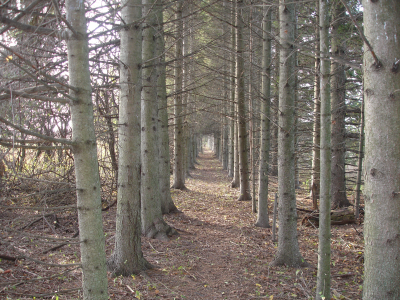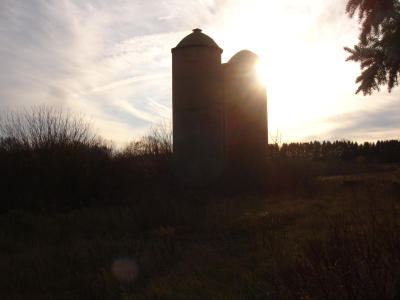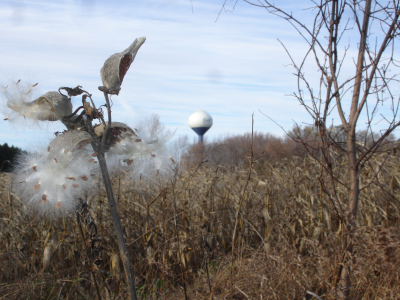“Fencerows”
10-28-12
I think this column has been going out weekly for about five months now. Internet technology moves fast, and since the beginning, time has gone by in a blur. Somewhere in the middle of that blur, Dick Ellis asked me what the title of my column should be.
I don’t move with the sudden flash of a digital signal flying overhead. I can’t deliver a point with the finger tapping ease of an instant text message. I use all the modern tools, but I can’t say that I fully understand them. I walk slowly. The way I fish and hunt would make a meandering snail impatient. I told Mr. Ellis, without hesitation, that I’d like it to be called “Fencerows.”

Fencerow pines along the Schroeter farmland.
I’ve never properly explained the title. Every so often I hear from someone who doesn’t really get the point of my writing in relation to the title, and I understand, because I often don’t even get the point of what I write about.
It goes something like this: I wander around the state, something neat pops up and seems to make perfect sense at the time-even if I’m the only one who considers it neat. I get distracted by something even better that pops up-and somewhere along the line something gets scribbled down and I call it “Fencerows”.
I’ll try to explain it further by saying that fencerows are those field stone piles of tangled, marsh-grass tree thickets that run between civilized fields in an endless pattern of straight lines and right-angled junctures. They are where hidden things hide in plain sight.
They are the single stands of trees where the deer sit and watch you for a great distance. Unless you go slow and step on them, they sit in those fencerows and laugh at you walking on past. They are places of shelter for grouse, turkey, mourning doves, and every variety of song bird that Wisconsin can throw at you.
If you find a fencerow, you find the start of a good day in the field. And if you follow a fencerow long enough, it has the potential to lead anywhere. It can run beneath towering power lines, or jump over an interstate or two, and it might run smack through a bustling city. A fencerow may even start in the middle of an urban jungle. Eventually, though, you can track a fencerow into the wildest reaches imaginable. Even if those wild reaches are within earshot of bustling town noises.

Abandoned silos rise from the past to meet the future.
My own fencerow is literally out my back door on the city’s edge of Grafton, and onto the 80 acres of the Schroeter homestead, where four generations have farmed, lived and pulled together the kind of life that stories are made of.
In my backyard fencerow is a tree house, wrapped around an oak and looking over the fields. The fort was built with railroad ties that were meant to hedge a garden, but that would mean I would have to weed the garden-promising to be a lot of work-so we built the fort instead.
From the tree, you can watch the deer come and go, and listen to the coyotes howl in the field thickets after dark. Even later after dark, the deer step lightly out of the field to pluck the flowers neatly off the top of my wife’s tulips, which I find funny, but my wife, oddly enough, does not.
Fencerows line the acres spreading from the tree fort. The Grafton water tower stands on one edge of a back tree line, surrounded by millions of dollars in potential real estate development. I’ll never be able to sell the tree house. Without the subsidies of a garden, we are financially upside-down on it.
Usually around this time of year, my family makes a pumpkin trek across the field to the farm, picking out just the right one from the Schroeter’s hay-wagon display. This year, they decided against the pumpkin crop, but I made the field trek anyway, because Halloween is Halloween, and it’s a time for stories, which by the way, you will always likely find along a fencerow. The Schroeter farm has more than its share, both stories and fencerows.
“My great grandfather bought the whole place for $8000 in 1904, he paid $1 down and scraped together the rest,” said Ken Schroeter, who has lived and worked the farm his entire life, and still has the original article of agreement hanging in the shed. “Eighty acres, the barn and the fieldstone farmhouse were all included in the deal.”
The original farmhouse still stands, dating back to the 1860’s. Ken Schroeter also has the first tractor that his grandfather bought, along with a collection of 19 other antique tractors that he keeps in a garage. “Before that, it was horses pulling plows and wagons,” said Schroeter. “That’s when it really meant something to up and go somewhere on the spur of the moment.” That’s a lot of ghosts of history floating around the fencerow farm.
“There was another farm that was supposed to go to the family, in the far northwestern corner of our land, where the Grafton water tower now stands,” said Schroeter. “But something happened along the way, there was a change in the will through a second marriage- Sabotageakt,” Schroeter named it in German as he told the story. It means sabotage. A Halloween story is not complete without something along those fencerow lines.
I have walked often enough along the back rock walls of the Schroeder’s, and seen the ruins of the silos and farm outbuildings from ages gone by. You are liable to find anything resting in the gullies, from rusted out red wagons, to old rolled strands of barbed wire. I found a pink stuffed teddy bear once, a bygone toy of some child, resting contentedly in a thorn thicket. I don’t understand how that stuff gets there, but I walk the fencerows to try and make some sense of it.
Ken’s sister, Marilyn, also lives on the farm and helps run it. She walked me to an overlook along the field edges and pointed out the property lines, where a high row of Norway pines stand along one edge, and a fieldstone fence stands along another.
The pine row is a straight-line tunnel, where with a stone’s throw out one side you hit a hayfield, and on the other it lands in the corn “They were planted 60 years ago,” Marilyn said. “I stand here and look at them everyday, and I try to walk the farm fencerows everyday. In those pines, you can almost hear the spirits of the past talking.”

The Grafton water tower holds an urban watch over the fields.
For many years the Schroeter’s have watched neighborhood kids run and play in their fencerows, and they don’t mind as long as the kids stay out of trouble for the most part, and out of the crops for sure.
Ghost stories have been concocted around the backyard fencerow fields, designed specifically for keeping my kids from trampling on the crops, and involving shapes that float above the fields, and though most are getting old enough to see through my nonsense, the kids faithfully stay out of the soybeans.
I’ve told the stories often enough, that they’ve started to become the stuff of neighborhood legend. I can’t remember when they even started, but come to think of it, I can’t remember the last time I’ve dared to step into the soybean field either.
So it is in the simple fencerow out my back door that I find the stories. That is where my column originates every week. It is not in the far reaches of snowy pines where I will go in search of wide-racked deer soon enough. It is not among the fallen aspen leaves of the grouse woods, or the frozen shores of late season musky waters, and the fencerows are not the spawning holes of late season steelhead.
But every week, I know if I follow the backyard fencerow far enough, it will lead to these things in due time. And every week I wonder what else might jump up along the way.









